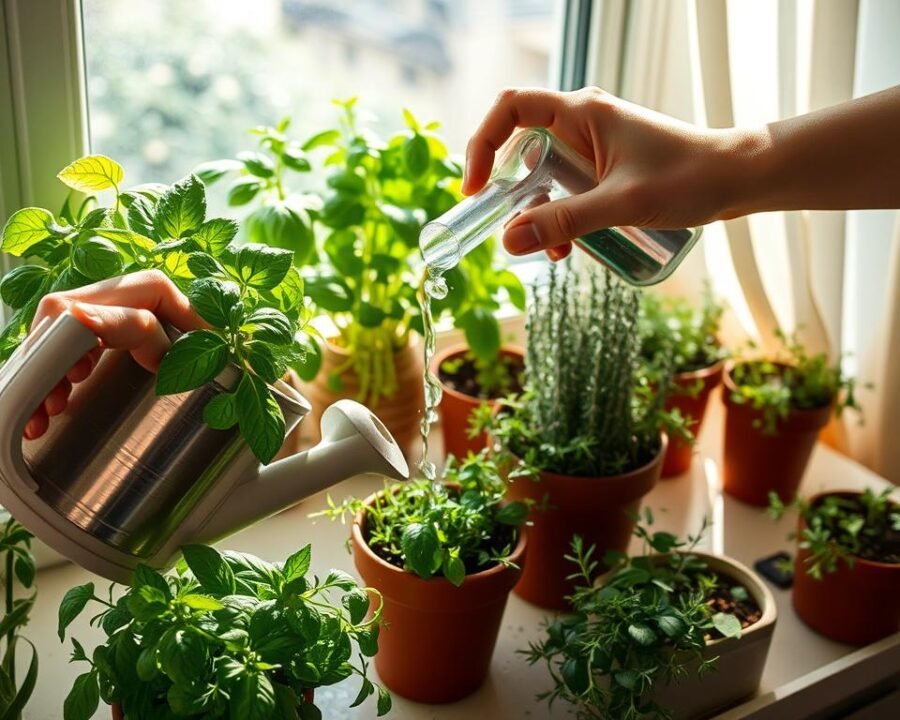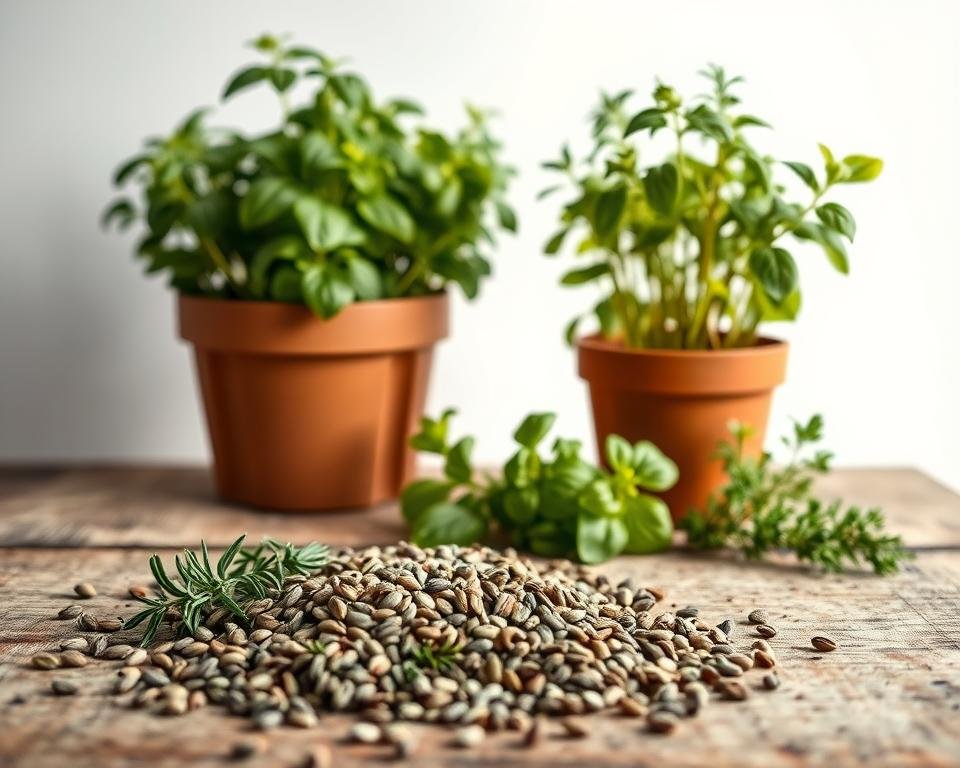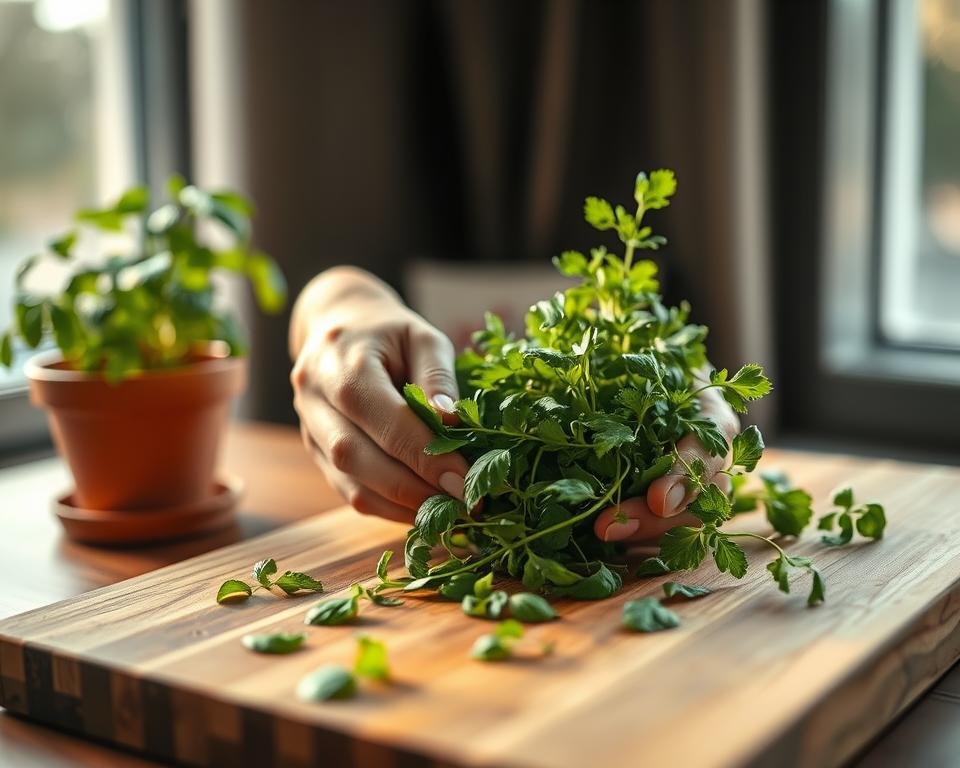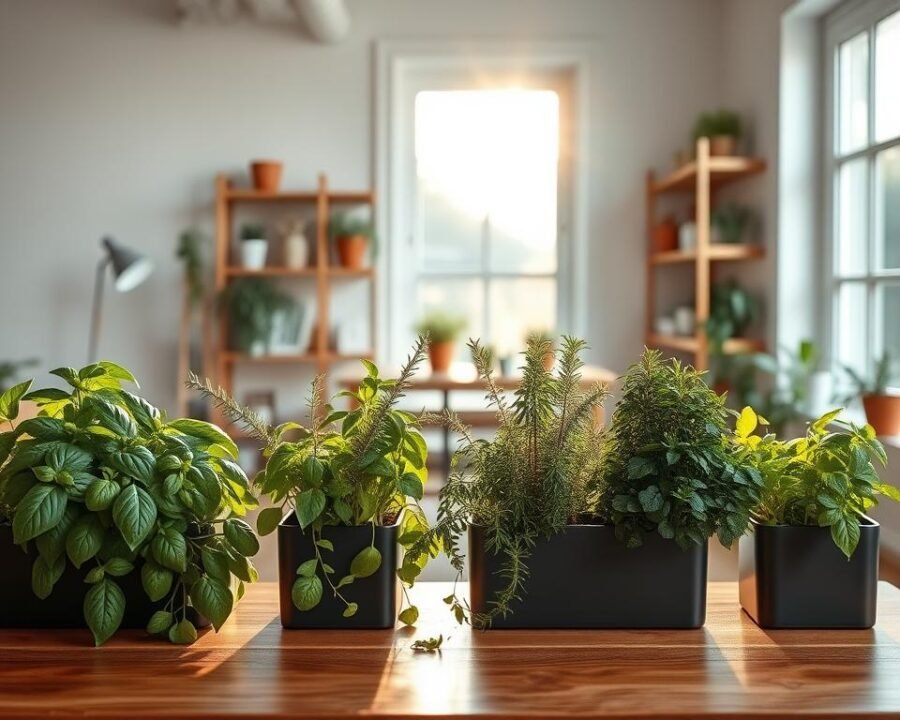There’s something magical about plucking fresh leaves straight from your own little garden. Whether it’s basil for pasta or mint for tea, having herbs indoors transforms cooking into a vibrant experience. No more wilted store-bought sprigs—just crisp, aromatic flavors whenever you need them.
Urban living doesn’t mean sacrificing greenery. Compact setups fit snugly on windowsills or countertops, bringing nature into even the smallest kitchens. Best of all? These tiny gardens thrive year-round, defying seasons and weather.
We’ve tested methods to avoid common pitfalls, like leggy stems or uneven growth. Our guide shares simple, proven techniques to keep your garden lush and productive. Ready to cultivate freshness daily? Let’s dive in.
Key Takeaways
- Enjoy fresh, flavorful herbs without trips to the store
- Perfect for small spaces like apartments and kitchens
- Grow your favorites regardless of outdoor conditions
- Learn expert tricks to prevent weak or sparse growth
- Get started with easy, space-smart solutions
Why Grow an Indoor Herb Garden?
Fresh, aromatic flavors transform ordinary meals into culinary masterpieces. A herb garden at home means no last-minute grocery runs—just vibrant leaves ready to enhance your dishes.
Fresh Flavors at Your Fingertips
Store-bought bunches wilt quickly, but homegrown herbs retain peak flavor. Try basil in caprese salads or cilantro in tacos—the difference is undeniable. Dried varieties lose 60% of their aroma, while freshly picked sprigs burst with intensity.
Combine three or more types for complex profiles: rosemary-thyme roasted chicken or mint-chive yogurt sauce. The possibilities are endless.
Cost-Effective and Space-Saving
One $4 plant yields 10 times more than pre-packaged bunches. Over a year, that’s $30 saved per variety. According to the National Gardening Survey, 68% of gardeners slash grocery bills significantly.
Even tiny kitchen corners work. A 24-inch windowsill fits six pots. One reader grew eight varieties in a studio apartment—proof that limited space isn’t a barrier.
How to Grow Indoor Herb Plant Pots Everyone Is Using
The secret to thriving greenery at home? Pairing the right plants with thoughtful setups. Whether you’re a beginner or a seasoned gardener, success begins with smart selections and the right tools.
Choosing the Right Herbs for Your Space
Compact varieties like thyme and oregano excel in 6-inch pots, while rosemary needs 10 inches to stretch its roots. For quick harvests, basil and parsley thrive in shallow containers.
Consider light needs too. Sage and lavender crave bright windows, whereas mint adapts to shade.
“Match your herb’s personality to your home’s conditions,”
suggests urban gardener Lisa Tran.
Essential Supplies You’ll Need
Start with the basics:
- Pots with drainage: Prevent root rot with holes at the bottom.
- Organic soil: FoxFarm’s blend nourishes roots without chemicals.
- Pruning shears: Fiskars’ stainless steel blades ensure clean cuts.
For precision, add a pH meter or humidity tray. Upcycled containers—like colanders or mason jars—add charm but need extra drainage holes.
Avoid overcrowding; give each plant room to breathe. Six inches between herbs prevents competition for light and nutrients.
Picking the Perfect Spot for Your Herbs
Location matters just as much as care when cultivating vibrant greenery inside. The right balance of light and space ensures robust growth, whether you’re nurturing rosemary or mint.
South- or West-Facing Windows: Best for Sun-Loving Herbs
Rosemary, oregano, and thyme crave 6+ hours of direct sun. South-facing window sills offer ideal exposure. In winter, rotate pots weekly to prevent lopsided growth.
Use a smartphone app like SunSeeker to track daily light patterns. DIY reflectors (aluminum foil behind pots) amplify brightness for leggy plants.
North- or East-Facing Windows: Ideal for Shade-Tolerant Varieties
Mint, chives, and parsley thrive with 4 hours of gentle morning light. East-facing spots work well, while north-facing ones suit low-light herbs year-round.
Signs of insufficient sun: pale leaves or stretched stems. Relocate pots or supplement with affordable LED options like Roleadro.
Using Grow Lights During Winter Months
Shorter days demand extra support. Opt for 5000–6500K bulbs (12–14 hours daily). Sansi’s 24W LED is a budget-friendly pick under $50.
- Winter care tip: Raise humidity with pebble trays.
- Prune leggy stems to encourage bushiness.
- Keep lights 6–12 inches above foliage to prevent scorching.
With smart placement, you’ll harvest fresh flavors regardless of the season.
Selecting the Best Containers
Healthy roots start with smart container choices. The right material and design prevent soggy soil or cramped growth. Let’s explore options that balance function and style.
Terracotta Pots: Classic and Breathable
These porous clay containers reduce overwatering risks by 40%. Their natural air circulation keeps roots oxygenated, ideal for herbs like rosemary. Just note—they dry out faster in hot climates.
Upcycled Containers: Budget-Friendly Options
Whiskey barrels or vintage tins add charm. Drill 3–5 drainage holes in the bottom to mimic a pot’s function. One gardener transformed colanders into hanging herb homes—creative and practical.
Self-Watering Planters for Low-Maintenance Care
These self-watering systems maintain perfect moisture for 7–10 days. Brands like Lechuza Classico use reservoirs to prevent root rot. Perfect for frequent travelers or busy cooks.
| Material | Pros | Cons |
|---|---|---|
| Terracotta | Breathable, prevents overwatering | Heavy, dries quickly |
| Ceramic | Stylish, retains moisture | Poor drainage if no holes |
| Plastic | Lightweight, affordable | Traps heat, less eco-friendly |
Pro tip: Match container width to your herb’s mature size. Basil needs 8–10 inches, while thyme thrives in 6–inch homes.
The Right Soil for Thriving Herbs
Great soil is the hidden hero behind every lush, aromatic garden. It anchors roots, delivers nutrients, and balances moisture—key for vibrant flavors. Most herbs prefer a slightly acidic to neutral pH (6.0–7.0). Start strong with these essentials.
Organic Potting Mix Basics
Garden soil is too dense for containers. Opt for lightweight organic blends like Espoma or Miracle-Gro Performance. These mixes include peat moss and perlite for airflow and drainage.
Signs of poor soil:
- Water pools on the surface
- Stunted growth or yellow leaves
- Foul odor (indicates rot)
“Invest in quality mix—it’s the bedrock of your herbs’ health,”
Enhancing Soil with Compost or Worm Castings
Boost fertility naturally. Fold in compost (1 part to 3 parts mix) or brew worm casting tea:
- Steep ¼ cup castings in 1 gallon water for 24 hours.
- Strain and water herbs monthly.
For soggy soil, add perlite (up to 30% volume). Test moisture by inserting a chopstick—dry crumbs mean it’s time to water.
| Amendment | Benefit | Best For |
|---|---|---|
| Compost | Adds microbes, nutrients | All herbs |
| Worm castings | Improves water retention | Basil, parsley |
| Perlite | Prevents compaction | Rosemary, thyme |
Pro tip: Refresh soil every 6–12 months to replenish nutrients. Your herbs will thank you with bold, endless harvests.
Watering Your Herbs the Right Way
Keeping herbs hydrated properly makes all the difference between limp leaves and vibrant growth. Too much or too little water stresses plants, but finding the sweet spot ensures lush flavors. Let’s explore the best way to quench their thirst.

Tender-Stemmed vs. Woody-Stemmed Herb Needs
Delicate herbs like basil crave water every 3–4 days, while rosemary thrives with drinks every 10–14 days. Why? Woody stems store moisture longer, whereas tender varieties wilt fast. Overwatering causes 85% of drooping—a common pitfall.
Signs to watch:
- Yellow leaves: Soggy roots (reduce watering).
- Crispy edges: Underwatered (check soil daily).
How to Check Soil Moisture
Skip guesswork with these pro methods:
- Finger test: Push a finger 1 inch deep—dry? Time to hydrate.
- Bottom-watering: Place pots in a tray; roots soak upward for even hydration.
“Morning watering cuts fungal risks by 50%—always aim for sunrise sessions.”
Urban tip: Collect rainwater in jars for chlorine-free drinks. Your herbs will taste purer and grow stronger.
Best Herbs to Grow Indoors
Few things rival the joy of snipping fresh basil for homemade pesto. With the right picks, your windowsill becomes a flavor powerhouse. These five varieties deliver robust growth and endless culinary perks.
Basil: A Must-Have for Pesto Lovers
Genovese basil yields ½ cup of leaves weekly—perfect for sauces. Cinnamon varieties add a spicy twist to desserts. Keep soil moist and trim tops to encourage bushiness.
Mint: Easy to Grow and Versatile
Apple mint naturally repels spiders while flavoring teas. Chocolate mint elevates desserts. Plant in separate pots; its roots spread aggressively.
Rosemary: Fragrant and Hardy
This woody herb thrives on neglect. Preserve sprigs in olive oil for roasted dishes. Needs bright light and infrequent watering.
Chives and Thyme: Beginner-Friendly Picks
Chives bloom edible flowers—steep them in vinegar for dressings. Thyme grows slower but rewards patience with earthy notes. Pair both in shared containers.
| Herb | Days to Harvest | Best Paired With |
|---|---|---|
| Basil | 60 | Tomatoes, oregano |
| Mint | 50 | Peas, carrots |
| Rosemary | 90 | Beans, sage |
| Thyme | 90 | Lavender, chives |
“Companion planting maximizes space and flavor—try basil with tomatoes for a win-win.”
Starting from Seeds vs. Nursery Plants
Kickstarting your green journey begins with a simple choice: seeds or starter plants? Both paths lead to lush herbs, but their timelines and care differ. We’ll break down the trade-offs to help you pick wisely.

Pros and Cons of Each Method
Seeds cost less ($0.50 each) and offer rare varieties, like purple basil. But they demand patience—basil sprouts in 5 days, while rosemary may take 21. Success rates vary: 70% for basil, 30% for rosemary.
Nursery plants skip the wait. Look for starters with 5+ leaves and sturdy stems. At $5 per plant, they’re pricier but guarantee a head start. Perfect for gardeners craving quick harvests.
“Soak seeds overnight in chamomile tea—it softens shells for faster sprouting.”
Where to Buy Quality Seeds or Starts
Trusted brands like Burpee and Local Harvest sell tested seeds. For organic starts, check farmers’ markets or gardeners in local swap groups. Heirloom varieties preserve unique flavors, while hybrids resist pests better.
- Budget tip: Split seed packs with friends to try more herbs.
- Hybrid alert: These won’t produce true seeds for replanting.
Whether you sow or transplant, both methods yield aromatic rewards. Match your pick to your patience and space.
Fertilizing for Lush Growth
Vibrant, aromatic leaves start with balanced nutrition. While herbs aren’t heavy feeders, strategic organic boosts keep them productive. Too little leaves them weak; too much sacrifices flavor—we’ll help you strike the perfect balance.
Organic Fertilizer Options
Natural amendments nourish without harsh chemicals. Fish emulsion (1 tbsp/gallon every 3 weeks) delivers a quick nitrogen punch. For a DIY way, steep banana peels in water for 48 hours—potassium-rich “tea” promotes sturdy stems.
Key organic picks:
- Worm castings: Mix ¼ cup into soil monthly for slow-release nutrients.
- Compost: Top-dress pots with ½-inch layers in spring and summer.
- Seaweed extract: Foliar spray every 2 weeks enhances stress resistance.
“NPK ratios matter—3-1-2 mimics herbs’ natural needs without overstimulating leaf growth at the expense of flavor.”
How Often to Feed Your Herbs
Fast-growers like basil thrive with biweekly feed during active growth. Woody types (rosemary, thyme) prefer monthly snacks. Overdoing it causes 23% flavor loss—stick to these guidelines:
| Herb Type | Frequency | Best Method |
|---|---|---|
| Leafy (basil, parsley) | Every 2 weeks | Root drench |
| Woody (rosemary, sage) | Monthly | Top-dressing |
| All-purpose | Seasonally | Soil refresh |
Winter demands less—reduce feed by half when growth slows. Always water before applying fertilizers to prevent root burn. For more tips, explore herb-specific fertilization strategies.
Pro tip: Flush pots every 3 months to prevent salt buildup. Pour water until it runs clear from drainage holes—your herbs will stay fresh and flavorful.
Harvesting and Using Your Herbs
Timing and technique turn homegrown sprigs into kitchen superstars. Whether you’re garnishing dishes or crafting herbal teas, proper methods maximize flavor and longevity.

When and How to Harvest
Morning cuts retain 15% more essential oils—ideal for intense flavor. Use sharp scissors to snip leaves just above a node. This “cut and come again” method encourages bushier regrowth.
For summer abundance:
- Basil: Pinch tops to delay flowering.
- Mint: Harvest whole stems to control spread.
- Woody herbs (rosemary): Trim ⅓ of growth to avoid stress.
“Always leave 2–3 sets of leaves—this keeps plants photosynthesizing for future harvests.”
Storing Fresh and Dried Herbs
Fresh sprigs last 1–2 weeks in damp paper towels inside airtight containers. For year-round use:
- Freezing: Blend basil into pesto and freeze in ice cube trays.
- Drying: Hang bunches upside-down in a dark, ventilated space.
- Infused oils: Submerge dried herbs in olive oil; refrigerate to prevent botulism.
Dried varieties stay potent 1–3 years in glass jars away from light. Repurpose extras into lavender sachets or mint tea blends for gifting.
| Method | Best For | Shelf Life |
|---|---|---|
| Freezing | Tender herbs (parsley, cilantro) | 6 months |
| Air-drying | Woody herbs (thyme, oregano) | 2+ years |
| Dehydrator | Quick, even results | 3 years |
Troubleshooting Common Issues
Even the healthiest greenery can face challenges—here’s how to solve them. From stretched stems to soggy roots, quick fixes restore vitality. We’ll tackle the top hurdles gardeners face indoors.
Leggy Growth: Fixing Light Deprivation
Spindly stems signal insufficient light. Move pots to south-facing windows or add LED grow lights (40% brighter). Rotate plants weekly for even exposure.
DIY solution: Craft a reflector with aluminum foil behind pots. For severe cases, prune leggy stems by half to encourage bushiness.
Yellowing Leaves or Root Rot
Yellowing leaves often mean overwatering. Check soil with the finger test—dry? Wait. Soggy? Repot with fresh mix and gravel for drainage.
For root rot, treat with 1:3 hydrogen peroxide solution. Trim blackened roots and reduce watering frequency. Improve air circulation with a small fan.
- Neem oil spray: Mix 1 tsp neem oil + 1 quart water to deter pests.
- Companion herbs: Plant chives near basil to repel aphids naturally.
- Repotting: Upgrade root-bound plants to pots 2 inches wider.
| Issue | Signs | Fix |
|---|---|---|
| Leggy growth | Long, weak stems | Increase light + prune |
| Yellow leaves | Soft, discolored foliage | Dry soil + repot |
| Root rot | Foul odor, black roots | Hydrogen peroxide treatment |
“Prevention beats cure—water only when needed and prioritize air circulation.”
Conclusion
Creating a thriving herb garden is simpler than it seems. Balance light, well-draining soil, and mindful watering for success. Start small—pick three favorites like basil, mint, or thyme to build confidence.
Share your progress! Tag us in photos of your leafy wins. We’ll explore advanced pruning and companion planting next time.
Every sprinkle of homegrown flavor makes meals special. Your kitchen oasis awaits—happy planting!
